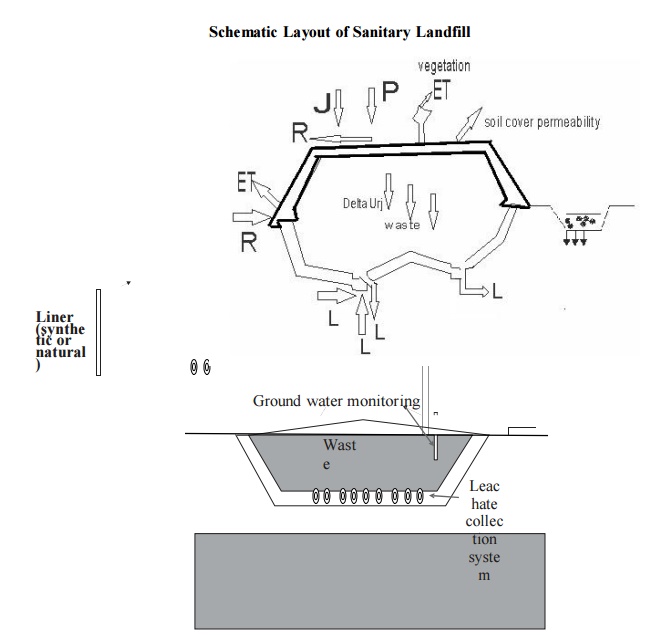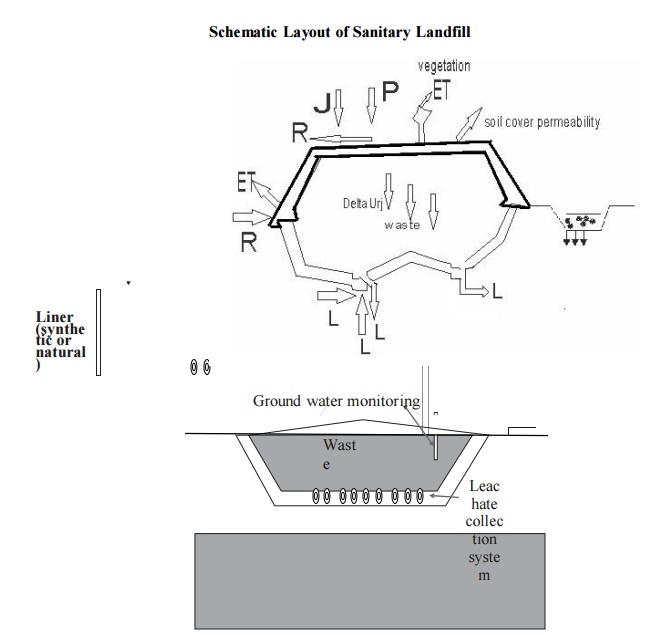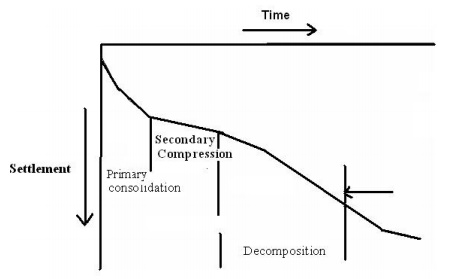Chapter: Civil : Municipal Solid Waste Management : Disposal
Sanitary Landfill

SANITARY LANDFILL
The term landfill
generally refers to an engineered
deposit of wastes either
in pits/trenches or on the surface.
And, a sanitary landfill
is essentially a landfill, where proper mechanisms are
available to control the environmental risks associated with the disposal
of wastes and to
make available the land, subsequent to disposal,
for other purposes. However, you
must note that a landfill need
not necessarily be an
engineered site, when the waste is
largely inert at final disposal, as in rural areas, where wastes contain
a large proportion of soil and dirt. This practice is generally designated as
non-engineered disposal method. When compared to uncontrolled dumping,
engineered landfills are more likely to have pre-planned installations,
environmental monitoring, and organised and trained workforce. Sanitary
landfill implementation, therefore, requires careful site selection,
preparation and management.
The
four minimum requirements you need to consider for a sanitary landfill are:
(i) full or partial hydrological isolation;
(ii)
formal engineering preparation;
(iii)
permanent control;
(iv)
planned waste emplacement and covering.
1Principle
The purpose
of land filling
is to bury
or alter the
chemical compos ition of the wastes so that they do not pose any
threat to the environment or public health. Landfills are not homogeneous and are
usually made up of cells
in which a discrete volume of
waste is kept isolated from adjacent waste cells by a suitable barrier. The
barriers between cells generally consist of a layer of natural soil (i.e.,
clay), which restricts downward or lateral escape of the waste constituents or
leachate.
Land
filling relies on containment rather than treatment (for control) of wastes. If
properly executed, it is a safer and cheaper method than incineration. An
environmentally sound sanitary landfill
comprises appropriate liners for
protection of the groundwater (from contaminated leachate), run-off controls, leachate collection and
treatment, monitoring wells and appropriate
final cover design (Phelps,
1995). Figure 4.1 below gives a schematic layout of sanitary landfill along
with its various components:

2 Landfill processes
(i) Site selection process and considerations: This requires the development of a working
plan - a plan, or a
series of plans, outlining the development and descriptions of site location,
operation, engineering and site restoration.
Considerations for site include public opinion, traffic patterns and
congestion, climate, zoning requirements, availability of cover material and
liner as well, high trees or
buffer in the site perimeter, historic
buildings, and endangered species,
wetlands, and site land environmental
factors, speed limits, underpass limitations, load limits on
roadways, bridge capacities, and proximity of major roadways, haul distance,
hydrology and detours.
(ii) Settling process: The waste body of a landfill undergoes different
stages of settling or deformation.
3 Settling Processes in
Landfill

The three
stages shown in the figure above are described below:
Primar y consolidation: During this
stage, a substantial
amount of settling occurs. This settlement is caused by the weight of
the waste layers. The movement of
trucks, bulldozers or mechanical compactors will also enhance this process.
After this primary consolidation, or short-term deformation stage, aerobic
degradation processes occur.
![]()
Secondary
compression: During this
stage, the rate
of settling is much lower than that in the primary
consolidation stage, as the settling occurs through compression, which cannot
be enhanced.
Decomposition: During
the degradation processes, organic material is converted into gas and leachate.
The settling rate during this stage increases compared to the secondary
compression stage, and continues until all decomposable organic matter is
degraded. The settling rate, however, gradually decreases with the passage of
time. To appropriately design protective liners, and gas and leachate
collection systems, it is, therefore, necessary to have a proper knowledge of the settling process of wastes.
(iii)
Microbial degradation process: The microbial degradation process is the most important biological
process occurring in a landfill. These processes induce changes in the chemical
and physical environment within the waste body, which determine the quality of
leachate and both the quality
and quantity of landfill gas (see Subsection 4.3.2).
Assuming that landfills mostly
receive organic wastes, microbial processes will dominate the
stabilisation of the waste and therefore govern landfill gas generation and
leachate composition. Soon after
disposal, the predominant part of the
wastes becomes anaerobic,
and the bacteria will start degrading
the solid organic carbon,
eventually to produce carbon dioxide and
methane. The anaerobic degradation
process undergoes the following
stages:
a) Solid and
complex dissolved organic
compounds are hydrolysed and fermented by the fermenters primarily to
volatile fatty acids, alcohols, hydrogen and carbon dioxide.
b) An
acidogenic group of bacteria converts the products of the first stage to acetic
acid, hydrogen and carbon dioxide.
c) Methanogenic
bacteria convert acetic acid to
methane and carbon dioxide and hydrogenophilic bacteria convert hydrogen and carbon dioxide
to methane.
The biotic factors that affect
methane formation in the landfill are pH, alkalinity, nutrients, temperature,
oxygen and moisture content.
Related Topics